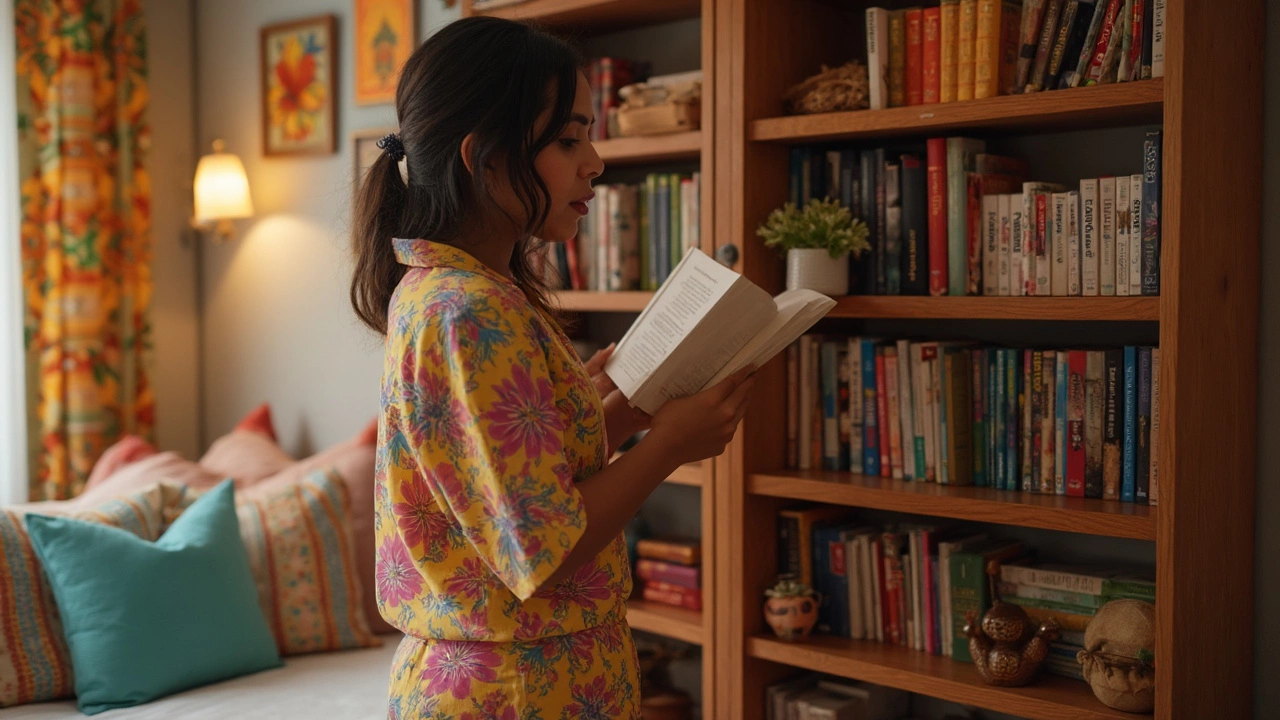Ever glance at your messy pile of books and wonder if a bookcase in the bedroom might help? You're not alone. Plenty of people face the same question—and it turns out, having a bookcase where you sleep isn’t just okay, it can be a game-changer for storage and comfort.
There’s no design rule against putting a bookcase in your bedroom. In fact, keeping your favorite reads close by makes bedtime stories or late-night study sessions way more convenient. For a lot of folks, seeing books lined up beautifully is relaxing, almost like having a piece of your personality on display.
But before you start moving furniture, think about your room’s shape and size. Maybe you’ve got an awkward nook or that empty wall across from your bed—both perfect spots for a slim shelf. You don’t need a huge library setup; even a small, freestanding bookcase can make your space more organized and cozy. If you’re tight on floor area, look up—wall-mounted shelves can hold more than you’d expect and keep things feeling open.
- Why Put a Bookcase in the Bedroom?
- Space-Saving Bookcase Ideas
- Bookcase Safety and Care Tips
- Bookcase Styles That Fit Bedrooms
Why Put a Bookcase in the Bedroom?
For a lot of people, the bedroom isn’t just a place to sleep—it’s a chill spot, a private hangout, and sometimes even a home office. Adding a bookcase to your bedroom makes sense if you love having personal stuff right where you spend the most time. Most Americans say they read in bed, and a survey from Pew Research Center in 2023 found that over 68% of bedroom readers wished they had better book storage in their room.
Having a bookcase in your bedroom keeps your favorite books, notebooks, or even your tablet in arms’ reach. That’s practical if you wind down every night with a novel or need quick access to reference stuff for late-night work. No more tripping over stacks on the floor or digging around for that book you swore you just saw yesterday.
It’s not just about books, either. Bookcases pull double duty as organizers for everything from photo frames to headphones to extra blankets. This makes them ideal for small bedrooms where you need furniture that does more than one job. Stacking storage vertically frees up space for other things, like a comfy chair or a cleaner look by your bed.
Check out this quick comparison table showing what a bedroom bookcase can help with compared to just piling stuff on a nightstand or dresser:
| Storage Method | Max Items (average) | Organization Level | Floor Space Used |
|---|---|---|---|
| Bookcase | 30-100+ | High | Medium to Low |
| Nightstand | 5-10 | Low | Low |
| Dresser Top | 10-20 | Medium | Already occupied |
And here’s the cool part: a well-placed bookcase can actually work as a privacy divider if you share a space. People have even used tall shelves as room blockers in studio apartments. So it’s flexible, smart storage that fits your everyday life—and solves the clutter problem fast.
Space-Saving Bookcase Ideas
If you’re short on space, the last thing you want is a clunky bookcase eating up half your bedroom. Good news—there’s a ton of ways to make book storage work, no matter how tight things are.
First up, go vertical. Tall, narrow bookcases make use of wall height, not just floor area. IKEA’s BILLY bookcase is a classic example—only about 11 inches deep, but it holds a surprising number of books, even in a small bedroom. If you really want to max out every inch, wall-mounted shelves are a winner. Just screw them right into the studs above your bed, desk, or dresser.
Love multi-purpose furniture? Try a headboard with built-in shelves or a storage bench that doubles as a mini bookcase. One popular trick is tucking a short bookcase under a window or at the foot of the bed—perfect for keeping your favorite reads close without messing with your main layout.
- Pick narrow bookcases for tight corners.
- Use floating shelves for tiny rooms or awkward walls.
- Look for under-bed storage options (some have pull-out drawers big enough for paperbacks!).
- Try ladder-style bookcases—they lean against the wall and take up barely any space.
If you want to see how much space an average bookcase needs, here’s a handy table:
| Bookcase Type | Typical Width | Typical Depth | Notes |
|---|---|---|---|
| Tall Narrow | 24-32" | 10-12" | Fits most bedrooms |
| Short Wide | 36-48" | 12-15" | Great under windows |
| Wall-Mounted | Varies | 8-10" | No floor space needed |
| Ladder Style | 18-28" | 12-16" | Leans against wall |
Katie Simpson, a well-known interior designer, says:
"Don’t underestimate small bedrooms. A smart, vertical bookcase can turn even a cramped corner into a tidy, stylish reading spot."
Keep in mind, if you want your bedroom to feel open, avoid overstuffing your shelves. Give each book a little breathing room, and mix in things like plants or small trinkets to break up the rows.

Bookcase Safety and Care Tips
Adding a bookcase in your bedroom sounds awesome, but it’s not just about where it looks good. Safety and upkeep matter—a lot. You don't want a wobbling bookcase or dusty shelves to mess with your peace of mind.
First off, always check if your bookcase is stable after setting it up. If you have kids, pets, or even sometimes bump into things yourself, use a wall anchor kit. According to the U.S. Consumer Product Safety Commission, over 25,000 people every year are injured by furniture tip-overs—most can be avoided with simple anchoring.
- Attach to the wall: Most modern bookcases come with anti-tip hardware. Take five minutes and use it, even if the unit seems solid.
- Watch the height: Tall, narrow bookcases tip easily. Keep heavier books on the lower shelves so everything stays weighted down.
- Keep clear walkways: Make sure your bookcase doesn’t block doors or your main pathway to the bed, especially in smaller rooms.
Dust and moisture are silent enemies for books and bookcases. Use a soft cloth or a microfiber duster every week to keep things tidy. Avoid loading your shelves until they sag; check weight labels, especially if your bookcase is made from manufactured wood.
| Material | Average Supported Weight (per shelf) |
|---|---|
| Solid wood | 35-40 lbs |
| Engineered wood | 15-25 lbs |
| Metal | 40-50 lbs |
Keep water glasses and plants with leaky pots off your bookcase. Too much moisture warps wood fast and can even cause mold. Rotate your books sometimes, especially the ones you rarely read, to stop dust from getting stuck on the same spot for months. For easy cleaning, line the back of your bookcase with shelf liner or thin contact paper—it protects both painted and natural surfaces.
Bookcase Styles That Fit Bedrooms
No matter what your bedroom looks like, there's a bookcase style that'll match both your taste and your space. Let’s get into the options that work best. This way, you don’t end up with a bulky shelf cramping your style or making the room feel packed.
If you’ve got a tight squeeze, go vertical. Tall, narrow bookcases take up barely any floor and make the most of wall height. IKEA’s BILLY is famous for a reason—it’s cheap, fits almost anywhere, holds a surprising amount, and you can paint it or add doors if you want a cleaner look. If you want something more subtle, floating shelves are life-savers for tiny rooms. Install a couple above your headboard or desk and you’ll keep your books up and out of the way.
For bigger bedrooms, low bookcases pull double duty. They work as a bedside table, or even a bench under the window with a few cushions tossed on top. Modular shelves are great for folks who want flexibility. You can stack, swap sections, or even build around corners. Cube bookcases, like the ones from Kallax, are super easy to customize with bins and baskets if you end up with more clutter than paperbacks.
Got kids? Go for short bookcases so they can reach their own books safely. Wall-mounted book ledges display covers forward, perfect for encouraging little readers (and they look cool, too). Always fix any bookcase to the wall if there's a chance of it tipping—especially in rooms where kids or pets play.
If you’re into design, match your shelves with other furniture or wall colors for a put-together vibe. Glass doors can keep dust away if you don’t read often, and open shelves work if you want quick access or like showing off those colorful covers. You don’t have to splurge, either—a bookcase from a thrift store with a fresh coat of paint often looks as good as new.

